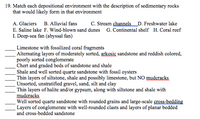
Applications and Investigations in Earth Science (9th Edition)
9th Edition
ISBN: 9780134746241
Author: Edward J. Tarbuck, Frederick K. Lutgens, Dennis G. Tasa
Publisher: PEARSON
expand_more
expand_more
format_list_bulleted
Question

Transcribed Image Text:**Matching Sedimentary Rocks with Depositional Environments**
**Question 19:** Match each depositional environment with the description of sedimentary rocks that would likely form in that environment. Choose from the following environments:
- A. Glaciers
- B. Alluvial fans
- C. Stream channels
- D. Freshwater lake
- E. Saline lake
- F. Wind-blown sand dunes
- G. Continental shelf
- H. Coral reef
- I. Deep-sea fan (abyssal fan)
**Descriptions:**
1. ___ Limestone with fossilized coral fragments
2. ___ Alternating layers of moderately sorted, arkosic sandstone and reddish-colored, poorly sorted conglomerate
3. ___ Chert and graded beds of sandstone and shale
4. ___ Shale and well-sorted quartz sandstone with fossil oysters
5. ___ Thin layers of siltstone, shale, and possibly limestone, but NO mudcracks
6. ___ Unsorted, unstratified gravel, sand, silt, and clay
7. ___ Thin layers of halite and/or gypsum, along with siltstone and shale with mudcracks
8. ___ Well-sorted quartz sandstone with rounded grains and large-scale cross-bedding
9. ___ Layers of conglomerate with well-rounded clasts and layers of planar bedded and cross-bedded sandstone
**Detailed Descriptions of Terms:**
- **Arkosic Sandstone:** Sandstone rich in feldspar, typically indicative of a nearby granitic source.
- **Conglomerate:** Coarse-grained sedimentary rock composed of rounded fragments.
- **Chert:** Hard, fine-grained sedimentary rock composed of microcrystalline quartz.
- **Mudcracks:** Cracks that form in drying mud, indicating exposure to air.
- **Cross-bedding:** Sedimentary rock feature where layers are inclined relative to the main bedding plane.
Explore each environment to understand the geologic processes that lead to the formation of these unique sedimentary rocks.
Expert Solution
This question has been solved!
Explore an expertly crafted, step-by-step solution for a thorough understanding of key concepts.
This is a popular solution
Trending nowThis is a popular solution!
Step by stepSolved in 9 steps

Knowledge Booster
Recommended textbooks for you
 Applications and Investigations in Earth Science ...Earth ScienceISBN:9780134746241Author:Edward J. Tarbuck, Frederick K. Lutgens, Dennis G. TasaPublisher:PEARSON
Applications and Investigations in Earth Science ...Earth ScienceISBN:9780134746241Author:Edward J. Tarbuck, Frederick K. Lutgens, Dennis G. TasaPublisher:PEARSON Exercises for Weather & Climate (9th Edition)Earth ScienceISBN:9780134041360Author:Greg CarbonePublisher:PEARSON
Exercises for Weather & Climate (9th Edition)Earth ScienceISBN:9780134041360Author:Greg CarbonePublisher:PEARSON Environmental ScienceEarth ScienceISBN:9781260153125Author:William P Cunningham Prof., Mary Ann Cunningham ProfessorPublisher:McGraw-Hill Education
Environmental ScienceEarth ScienceISBN:9781260153125Author:William P Cunningham Prof., Mary Ann Cunningham ProfessorPublisher:McGraw-Hill Education Earth Science (15th Edition)Earth ScienceISBN:9780134543536Author:Edward J. Tarbuck, Frederick K. Lutgens, Dennis G. TasaPublisher:PEARSON
Earth Science (15th Edition)Earth ScienceISBN:9780134543536Author:Edward J. Tarbuck, Frederick K. Lutgens, Dennis G. TasaPublisher:PEARSON Environmental Science (MindTap Course List)Earth ScienceISBN:9781337569613Author:G. Tyler Miller, Scott SpoolmanPublisher:Cengage Learning
Environmental Science (MindTap Course List)Earth ScienceISBN:9781337569613Author:G. Tyler Miller, Scott SpoolmanPublisher:Cengage Learning Physical GeologyEarth ScienceISBN:9781259916823Author:Plummer, Charles C., CARLSON, Diane H., Hammersley, LisaPublisher:Mcgraw-hill Education,
Physical GeologyEarth ScienceISBN:9781259916823Author:Plummer, Charles C., CARLSON, Diane H., Hammersley, LisaPublisher:Mcgraw-hill Education,

Applications and Investigations in Earth Science ...
Earth Science
ISBN:9780134746241
Author:Edward J. Tarbuck, Frederick K. Lutgens, Dennis G. Tasa
Publisher:PEARSON

Exercises for Weather & Climate (9th Edition)
Earth Science
ISBN:9780134041360
Author:Greg Carbone
Publisher:PEARSON

Environmental Science
Earth Science
ISBN:9781260153125
Author:William P Cunningham Prof., Mary Ann Cunningham Professor
Publisher:McGraw-Hill Education

Earth Science (15th Edition)
Earth Science
ISBN:9780134543536
Author:Edward J. Tarbuck, Frederick K. Lutgens, Dennis G. Tasa
Publisher:PEARSON

Environmental Science (MindTap Course List)
Earth Science
ISBN:9781337569613
Author:G. Tyler Miller, Scott Spoolman
Publisher:Cengage Learning

Physical Geology
Earth Science
ISBN:9781259916823
Author:Plummer, Charles C., CARLSON, Diane H., Hammersley, Lisa
Publisher:Mcgraw-hill Education,